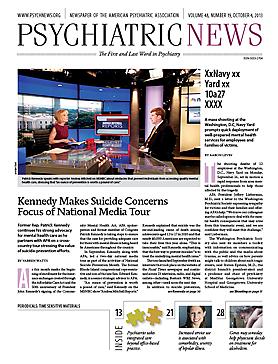There has been a substantial reduction in the size of the earnings gap separating male and female workers in the United States, from 30 percent in 1987 to 15 percent today. Thus, Anupam Jena, M.D., Ph.D., an assistant professor of health care policy and medicine at Harvard Medical School, anticipated that these positive findings would translate into closing the pay gap between male and female physicians as well.
This is, however, not what he and his colleagues found in a recent study, he told Psychiatric News. If anything, the pay gap has grown wider, they reported in research published online September 2 in JAMA Internal Medicine.
Using data from more than 6,000 physicians from 1987 through 2010, Jena and colleagues analyzed trends in average annual earnings from three time periods—1987 to 1990, 1996 to 2000, and 2006 to 2010. They took possibly confounding factors such as age, hours worked, years of experience, and state of residence into consideration. Dollar values were normalized to 2010 dollars.
They found that male physicians earned $33,840 (20 percent) more than female physicians in the 1987 to 1990 period; $34,620 (16 percent) more than female physicians in the 1996 to 2000 period, and $56,019 (25 percent) more in 2006 to 2010.
Assuming that these findings are an accurate picture of the physician pay situation, Jena suggested several possibilities for the persistence of the pay gap. The gap may be attributable, at least in part, to “different preferences of female physicians, such as a desire to work in jobs within a given specialty that are more lifestyle-friendly and that consequently require a tradeoff between income and lifestyle,” he noted.
Another explanation could be “a relative lack of access to particular specialties or types of job opportunities…. We know that because women comprise a larger fraction of medical school graduates today than 20 years ago, women are more prevalent in all specialties. However, several are still heavily male-dominated, and these tend to be those that are higher paying, on average.”
Molly Cooke, M.D., a professor of clinical medicine at the University of California, San Francisco, suggested in an accompanying commentary that traditional “old boys networks” could also be affecting the pay levels of women physicians.
All things considered, “The report and accompanying commentary provide more data in support of what I have experienced and observed in almost 50 years of medical practice,” former APA President Carolyn Robinowitz, M.D., commented to Psychiatric News.
So what might women physicians do to close the pay gap?
“We first have to understand what the source of the gap is,” Jena told Psychiatric News. “If the gap is simply due to differences in preferences between male and female physicians for the type of specialty to work in and the type of practice to join, this isn’t necessarily an issue that needs addressing. However, we suspect that some of the gap we are seeing is unrelated to the choices women physicians would make if they did not perceive certain specialties to be male dominated. I think that the most important step has already been taken. Female physicians now comprise more than 50 percent of all medical graduates, and within the next decade will likely account for nearly 50 percent of the physician workforce. As more female physicians become interested in traditionally male-dominated fields, I think we will see further equalization in numbers between male and female physicians in higher-paying specialties.”
The study was funded by the National Institute on Aging. ■
